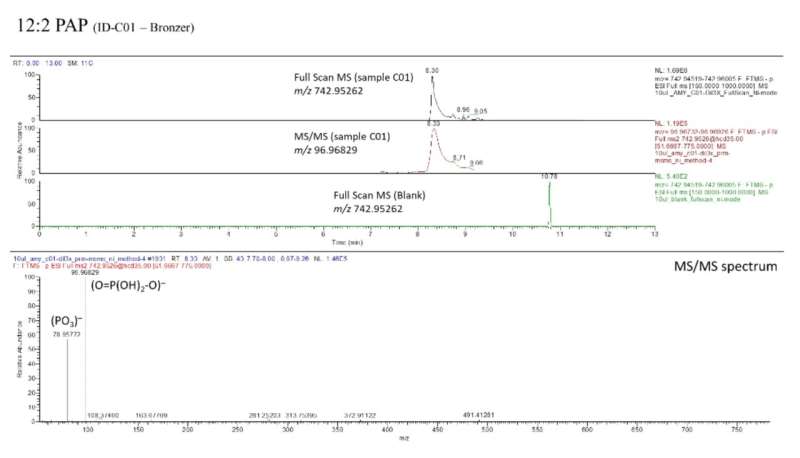Full Scan MS chromatogram of 12:2 monoPAP in sample ID-C01 (Bronzer) and blank, and corresponding MS/MS spectrum at NCE = 35%. Logical retention time pattern in the homolog series (6:2 monoPAP: 5.0 min; 8:2 monoPAP: 6.2 min; 10:2 monoPAP: 7.2 min; 12:2 monoPAP: 8.3 min) and observation of two characteristic MS/MS fragment ions, supported classification of 12:2 monoPAP as a type 2 analyte (Probable structure). Credit: Environmental Science & Technology (2022). DOI: 10.1021/acs.est.2c02660
Smooth, foamy, water-proof. These characteristics are extremely desirable in beauty products, but manufacturers sometimes use ingredients that contain fluorine—including potentially harmful per- and polyfluoroalkyl substances (PFAS)—to achieve them. Now, researchers reporting in ACS' Environmental Science & Technology show that some cosmetics and personal care products labeled as having fluorinated components also contain PFAS, whether or not these "forever chemicals" were listed as ingredients.
Although the most concerning PFAS are no longer used in many beauty products, in some cases they've been replaced with other classes of PFAS that have unknown health and environmental impacts. And a 2021 study in Environmental Science & Technology Letters found that numerous cosmetics in the U.S. and Canada still contain these substances.
However, it's unclear whether these compounds are in personal care products, such as creams, cleansers, shampoos and shaving creams. So, Amy Rand and colleagues wanted to examine a variety of beauty products that listed fluorinated components in their formulations for the presence of PFAS.
In 2020 and 2021, the team purchased 38 beauty products available from local stores in Canada and online that contained organofluorine compounds and analyzed them for older types of PFAS. All of the samples had measurable levels of PFAS, but some of the detected compounds weren't listed as ingredients in the products.
The levels found in personal care products were generally lower than in cosmetics. And the team identified that two foundations, labeled with terms similar to "water-proof," had high levels of total PFAS, one of which had thousands of parts per million (ppm), a level that exceeds proposed Canadian PFAS regulations.
Then, the researchers took a subset of the purchased items and screened them for over 200 additional PFAS, including the emerging classes that are replacing legacy compounds. One emerging class—monohydrogen substituted perfluoroalkyl carboxylic acids—was found in 30% of the subset with amounts from less than one ppb to hundreds of ppb.
During this analysis, they also found a variety of structurally diverse PFAS that didn't appear to be related to the PFAS originally added to the products, which the researchers suggest could be the result of product aging or contamination from impurities in raw materials. These results show the diversity of PFAS compounds, and the wide ranges of their amounts, present in some cosmetics and personal care products currently sold in Canada, but the researchers say more work is needed to understand where unexpected PFAS come from.
More information: Keegan J. Harris et al, Targeted and Suspect Screening of Per- and Polyfluoroalkyl Substances in Cosmetics and Personal Care Products, Environmental Science & Technology (2022). DOI: 10.1021/acs.est.2c02660
Heather D. Whitehead et al, Fluorinated Compounds in North American Cosmetics, Environmental Science & Technology Letters (2021). DOI: 10.1021/acs.estlett.1c00240
Journal information: Environmental Science & Technology Letters , Environmental Science & Technology
Provided by American Chemical Society
























